The Adelaide Festival delivers real vitality with Olwen Fouéré’s riverrun. The 2015 program draws audiences to the experiential, with Blinc installations lighting up the Torrens Riverbank, and Bill Viola’s exhibitions and the Cedar Lake Contemporary Ballet headlining the festival.
In selecting riverrun, Artistic Director David Sefton taps into this energy. The performance is phenomenal, in both senses of the word. Successfully adapting material from James Joyce’s Finnegans Wake, and the immediacy of riverrun in performance, are quite remarkable. Fouéré and her team have unlocked a theatrically from Joyce’s work, and if the audience is prepared to join them, they will find a surprising energy in riverrun.
It is a performance piece rather than a drama. Characters are present, but they do not underpin riverrun. Instead, moments ebb and flow and Fouéré catches them. She is an ever changing vessel, voicing a cast of characters that run to Anna Livia Plurabelle (ALP), the voice of the river.
Fouéré describes the performance as a sound-dance, and this idea is the central aspect of the work. Fouéré’s performance explores the boundaries of language and movement in the theatre space.
The Dunstan Playhouse is stripped to its bare walls.
A lighting grid above, and two banks of lights setting a border on the floor, define the space. Fouéré stands on stage waiting as the audience enters, her shock of white hair pulled back, and dressed in a dark grey suit. There is a sense of androgyny in Monica Frawley’s costume design, which plays well with the varied voices in performance.
A gentle humming resonates in the theatre. Alma Kelliher’s sound-scape, something not unlike moving water and not unlike breath, carries Fouéré’s performance.
She begins by removing her shoes. Then carefully treads along the edges of the space, before arriving at a microphone atop a curved stand. She chants “Sandhyas”, opening harmonics in her voice as she throat-sings the Sanskrit words, meaning the twilight of dawn. The house lights gradually darken, Fouéré’s chanting continues, she is inviting the audience into her river.
In it, Fouéré speaks in Joyce’s experimental language. Meaning is layered, multiplied and very slippery. Phrases float to the surface, though there is a sense there is more beneath. In Fouéré’s Irish dialect, “May he live for river”, and, “Give us today our maily bag”, sound familiar, if unstable.
Around these verbal gymnastics, Stephen Dodd’s lighting gently rocks and rolls over the space, evoking the feeling of being afloat. The design, the light and sound, coalesce with Fouéré’s deliberate and meditative performance. They punctuate, along with Fouéré’s precise physicality, the flow of performance, which moves through rapids and tributaries.
Each movement of the performance is given space, closing with the sound of Fouéré’s breath as she blows into the microphone, before it takes a new direction. The accumulative effect draws the audience into Joyce’s world.
There have been several variations of riverrun, with seven performed readings and extensive collaboration to bring this work to the stage. It origins lies in a 2011 reading of Finnegans Wake for Bloomsday. Fouéré, reading from the last page of the Wake, noticed something change in the room. This confirmed for her the desire to explore it performance.
In her notes to riverrun, Fouéré highlights what Joyce wrote to Arthur Power:
The important thing is not what we write, but how we write, and in my opinion the writer must be an adventurer above all.
Fouéré is adventurer in this performance. Language flows free and the audience learns it is not what we hear and see but how we hear and see it. To grasp the performance a different sensibility is required.
Alongside Fouéré the audience is drifting from moments of recognition to moments of amusement and bewilderment. Much like listening to music, intuition takes over intellect. In one instance, Fouéré whistles, and paces round the boundaries of the space. The tune is It’s a Long Way to Tipperary, though perhaps it is only a snippet. The rhythm and and tone are stilted and we only begin to hear it when our attention slips.
Throughout this performance, the physical gestures, design and Joyce’s language, all function at this intuitive level. It is theatre that is raw, simple and full of life. The technical precision from Fouéré is something to behold, and her team of designers have seamlessly integrated their crafts in riverrun.
The performance flows toward the voice of the river, the monologue of ALP. It is a final meditation on the cycles of life, where she and the river become archetypal, the energy of the performance building to the moment of release. Then Fouéré utters Joyce’s incomplete sentence. The river runs to the twilight of dawn. The audience released from the dream invigorated and renewed.
riverrun is performed at the Adelaide Festival until March 2. Details here.

